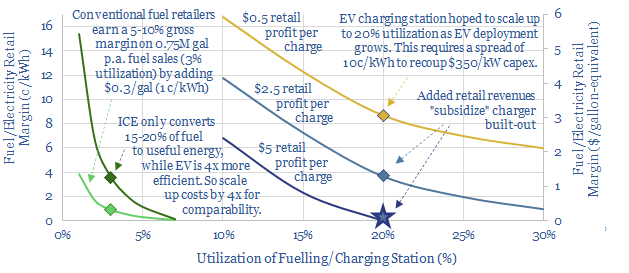This 14-page note compares the economics of EV charging stations with conventional fuel retail stations. They are fundamentally different. Our main question is whether EV chargers will ultimately get over-built, as retailers look to improve their footfall and accelerate the energy transition. This means prospects may be best for charging equipment and component manufacturers.
To set a baseline, this note starts by reviewing the economics of conventional fuel retail stations, covering their typical costs, throughputs, fuel margins and convenience retail margins, on pages 2-4.
More electric vehicles are needed in the energy transition. Our estimates of volumes, oil market implications, and CO2 credentials are refreshed on page 5.
So how do the economics compare for EV chargers versus conventional fuel retail? We outline our numbers for an EV ‘fast charging station’ on pages 6-9, covering barriers to entry, throughput volumes, utilization factor aspirations, required margins, ultimate energy costs, and retail incentives. Electric vehicle chargers can also provide demand shifting services to help backstop increasingly renewable-heavy grids.
This market structure is what makes us think EV chargers could ultimately get over-built, and this idea is fleshed out on page 10.
Could EV charging technology change in the future? We review the three technologies we would be watching on page 11.
Which companies are best-placed? We close with observations on better-placed companies, on pages 12-14, including specific examples from our patent reviews.

